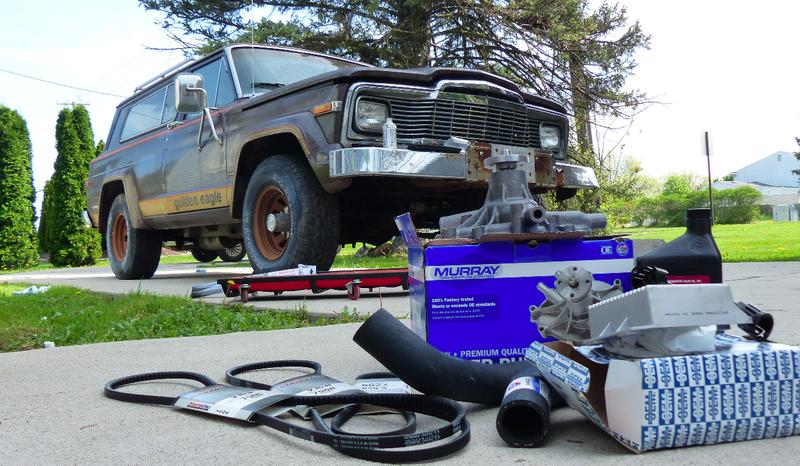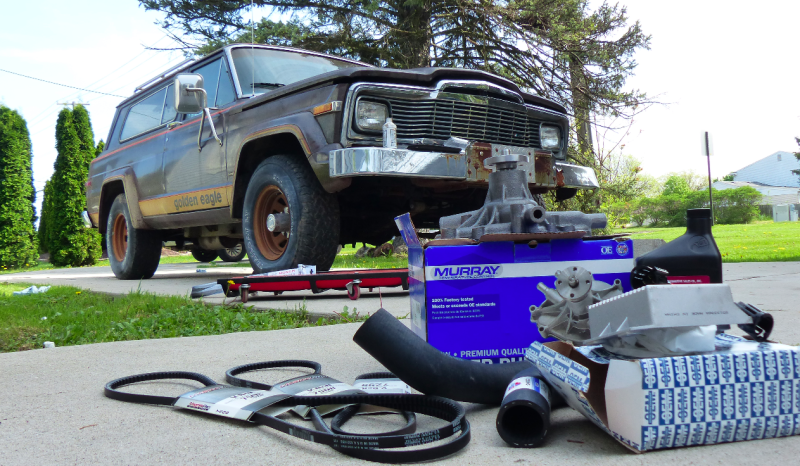
Right now, I’m trying to get my 1979 Jeep Cherokee Golden Eagle on the road, and I’m struggling to answer a question: How much preventative maintenance should I do? (Because this is getting expensive).
Over the past few days, I’ve been ruining my wallet by purchasing a metric crap-ton of replacement parts for my Golden Eagle, and that got me thinking: Should I even replace all these components?
This Jeep has been sitting for at least seven years based on the registration in the glovebox, which is why I decided to replace a number of wear items like the radiator hoses. Those were about $15 each. The top hose had already been chewed into by the A/C pulley, so I figured that—since I’m draining the cooling system anyway—I may as well do the bottom hose.
And at that point, I thought I might as well do the water pump, since I don’t know when that was replaced, and I also am deathly afraid of overheating. That cost me about $35. I may as well throw a $7 thermostat in while I’m at it, and it’s always good to replace the radiator cap, since those are cheap, too at only $5. Plus, since the fan will have to come off to replace the water pump, I should probably put a new fan clutch in there. You know, because it’s not worth risking overheating, and it’s only another $25.
Advertisement
I should also replace the spark plugs, distributor cap, coil, rotor and wires, since those are relatively cheap, and they’re items that frequently go bad. Plus, I’ll snag an ignition module while I’m at it, since those are notorious for failing in full-size Jeeps. Last thing I want is to break down because I didn’t swap such cheap parts.
As for the brakes, I know nothing about them, either. They work, but for how long? There are a number of rubber components in the brake system, which can all go bad over time. So I’m planning on swapping the hoses, wheel cylinders (those are only $9 a pop), calipers ($17 each) and maybe even the master cylinder ($19). I can probably afford these parts, but I cannot afford to have a brake failure.
Advertisement
Anyway, you can see why I’m conflicted: These costs add up quickly. But I don’t have the Jeep’s service history, and—especially with cooling system parts—not replacing the components seems like too high of a risk, and it’d also just be silly to keep the old parts in there since I’m in replacing the radiator hoses already.
But these ideas of “Peace of Mind” and “While you’re in there, you may as well replace…” are slippery slopes that are quickly putting me into the poor-house. On the other hand, once I have replaced all these components and replaced all the fluids and filters, I’ll be driving this thing with confidence, tackling long trips without worrying about breaking down, and I think there’s value in that.
But my colleague Raphael doesn’t quite agree with my methodology.
Raphael Orlove — If It Ain’t Broke Don’t Fix It
Advertisement
Raphael: Swapping out wheel cylinders that aren’t even busted? Oh man. The optimism.
I understand this give-a-mouse-a-cookie approach to automotive ownership, but it’s one that I avoid as much as absolutely possible. If anything has been the enemy of my old car ownership, it has been actually trying to fix anything. More often than not, my attempts to repair my car ends up with me breaking it, or finding out that a different part is broken than I ever anticipated.
It’s not that I don’t like fixing my car. It’s not like I don’t think the parts of my car should be broken shouldn’t be fixed. It’s just that I’ve learned with an old enough car, every time I try to fix anything, I run the risk of breaking something that already sort of works. And that risk is usually greater than the possibility of making my old car better.
Advertisement
I swear, I was optimistic once. That was before the problems started.
Just last weekend I drove my car up to a friend’s shop to re-mount my rear shocks with proper spacers (from when I mis-mounted them the last time I put them on), only to find out that not only had I forgotten the spacers at home, but also that the car was running on one cylinder at idle, all four only under full load.
Advertisement
I tried troubleshooting the ignition system, tightening the worryingly loose spark plugs and then replacing the plug wires only to end up with a car that ran on two at idle and three at full load. If anything, my car was worse than it was before I started.
I ended up calling it a day at about six in the evening, knowing that rain was coming in and night was imminent. Not a good time to really have to macgyver any potential roadside repair. I pootled home on either three or four cylinders without much issue and my car sits awaiting a complete new ignition system. With a Volkswagen, at least, that will cost me about five bucks and should take maybe an hour to swap over.
Advertisement
And that’s all sort of why I have a new, complete wiring harness sitting unused in a box. The wiring in my car might be wonky, but the car goes and stops and largely works. I can’t be sure that would still be true if I went through the trouble of pulling out all the still-kinda-ok wires along with all the bare, terrible, busted ones in the car at the moment.
I’ve stripped too many old threads to go down any kind of rabbit hole I don’t need to. Am I an idiot? Probably, but at least my car runs. Mostly.















